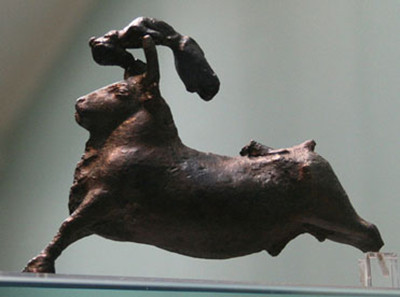There are three main techniques we had to learn: first the 'recorte de rinon' (the kidney cut); second it's the 'quiebro' (the break or the swing); the third one is the 'salto' (or leap), which is mainly jumping right over the bull in a different variety of styles.
有三種主要技術需要學習,一是“recorte de rifi6n”(切腎);二是“quiebro”(翻轉),三是“salto”(跳躍),其實就是幾種不同跳到牛背上的姿勢。
"Remember that the bulls are not injured before the match like in the bullfighting.
跟斗牛比賽不同,我們不會在賽前故意剌傷公牛,
The bull never dies in the arena.
也不會在場上將它們殺死。
We are risking our lives here, we get butted and gored as frequently as bullfighters. The bull is unpredictable.
我們從事這項運動的人都是在玩命,像斗牛士一樣常常被牛頂,被牛角戳。你猜不透牛的想法,
He is the one in charge...We never lost a respect for the bull."
是它在掌控全場。我們永遠對公牛充滿敬意。
I think what Sergio Delgado says is quite fascinating, because it confirms scholars' suggestions that bull-leaping on Crete at the time of this little statue would probably have had a religious significance.
如前所述,一些學者認為,在制作這尊雕像的那個年代,跳牛飛人很可能有一些宗教含義。用于制作雕像的昂貴青銅也說明它是神的祭品。
Even the bronze it's made of suggests an offering to the gods.
這種延續到現代的對牛的尊重,正好與他們的觀點形成了絕妙的呼應。
It was made around 1700 BC in the middle of what archaeologists call the Bronze Age, when huge advances in making metals transformed the way humans could shape the world.
這尊雕像制作于公元前一千七百年,正處于被考古學家命名為青銅時代的年代的中期。當時人類在金屬鍛造方面取得了巨大進步,改變了人類塑造世界的方式。
Bronze, an alloy of copper and tin, is much harder and cuts much better than copper or gold, and once discovered, it was widely used to make tools and weapons for over a thousand years.
青銅是銅與錫的合金,比銅或金都要更堅硬、切割的效果也更好,自一千多年前被發現起就一直用于工具和武器制作。
But it also makes very beautiful sculpture, and so it was quickly used, as you can see from this bull leaper, to make precious, probably devotional objects.
同時它也用于制作美麗的雕像,因此通常用來制作珍貴的祭神物品。












